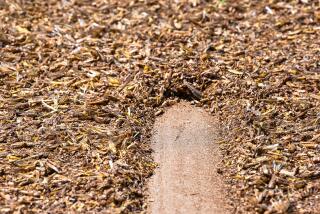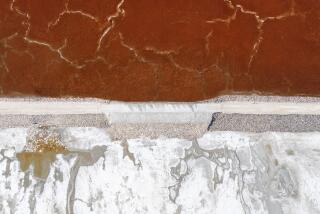Drought Produces Bumper Crop of Farm Pests : What Heat Doesn’t Kill, Bugs Eat
- Share via
CHICAGO — Grasshoppers are swarming over Gary Broyles’ Montana farm, aphids are stealing sap from Bob Wallace’s sugar beets in California and spider mites in Illinois have almost finished off Ron Mann’s clover and are moving in on his soybeans.
What the drought is not killing on the nation’s farms, insects seem to be eating. “It is not like the plague or anything like that but locally insects can hurt some and potentially cause lower yields,” said Dave Noetzel, a Minnesota entomologist.
Hot, dry conditions are wilting corn, wheat, soybeans and other agricultural staples across much of the country. They also have produced a bumper crop of bugs like grasshoppers, aphids and spider mites that thrive in such weather. And that is only making it tougher for farmers to salvage their crops.
Suck Plant Liquids
The bugs are especially dangerous in times of drought because they suck liquids from plants that are already dehydrated.
Broyles said that he doubts he will have 10 bushels of barley left after grasshoppers finish chewing on leaves and stems on his farm near Billings. “The drought is the biggest problem but the ‘hoppers are running a close second,” he said.
While human activity seems to slow as temperatures soar, insect activity speeds up as the cold-blooded creatures bask in hot weather. “The weather is great for aphids,” explained Donald Lewis, an Iowa State University entomologist.
Entomologist Eric Mussen of UC Davis describes “an aphid explosion” in the central Sacramento Valley. Bug experts say that Iowa and Illinois are also experiencing the worst aphid infestation in recent memory.
On Wallace’s ranch in Arbuckle, northwest of Sacramento, armies of tiny, pear-shaped aphids already have infested mature sugar beet crops and are now marching on newly planted ones, seriously threatening the potential yield. Either green or multicolored and so small that they could fit on a pinhead, the aphids carry viruses that can stunt plant growth, reduce yields and alter the color of the plants they infest.
Stress of Drought
The more drought-stressed the plants become, the more those insects depend on the nutrition that they derive from the dwindling supply of plant juices.
“The insects are not going to survive with the dying plants,” explained Edward Lace, director of the Sand Ridge Nature Center near Chicago. “They need the plant juices. It is just like us eating cereal without milk. Insects need moisture just as we do.”
There are thousands of species of aphids, virtually as many as there are plants for them to feed on. In California, aphids gather for a meal in sugar beet and melon fields. In the Southeast, they feast on tobacco. And in the Midwest, the insects sink their piercing beaks into soybeans, corn and barley. They also seek out shade and fruit trees, vegetable gardens and ornamental plants.
Huge concentrations of aphids not only can destroy crops for farmers but they can create sticky situations for city dwellers. When they eat more than they can digest, the bugs secrete a sugary substance called “honeydew” onto plants and trees. Drippings from trees often coat the ground with a sticky, albeit harmless, goo.
“You can hear the cars out there sticking to the streets,” said James A. Fizzell, an urban horticulturist. “It is not the tar, it’s the honeydew. It is like clear molasses.”
Hard to See on Plants
For Mann, the problem is spider mites, rather than aphids. But the effect is pretty much the same as the microscopic, eight-legged mites move in on his southern Illinois farm. So far, they have devoured 80% of his clover crop and are starting to kill his soybeans. “I can’t even see them, you need a hand-held eyepiece to be able to see them on the underside of the leaf,” Mann said.
Spider mites infested more than a million acres of Illinois soybeans during the last major Midwestern drought in 1983 and could prove just as serious a problem this year. “Unless the hot, dry weather abates, we will have a problem again,” said Kevin Steffey, a University of Illinois entomologist.
Mann said that sprays can kill the mites but he said it is not worth the investment because what the mites do not destroy the drought probably will.
The pest news is not all bad, however. While the drought is increasing some insect activity, it is also thinning the ranks of other bugs like mosquitoes and flies. Mosquito eggs, for example, must hatch in water. Without rain, according to one bug expert, the population of those pests could plummet to one-eighth of normal levels.
The numbers of aphids might be way up because of the drought, but so are the numbers of predators such as ants and lady beetles that feed on aphids. “There is something good out of the drought,” Lewis said. “We’re seeing the lady beetles out at work.”
More to Read
Sign up for Essential California
The most important California stories and recommendations in your inbox every morning.
You may occasionally receive promotional content from the Los Angeles Times.










